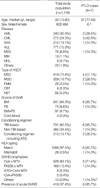1. Loren AW, Porter DL, Stadtmauer EA, Tsai DE. Posttransplant lymphoproliferative disorder: a review. Bone Marrow Translpant. 2003. 31:145–155.

2. Cohen JI. Epstein-Barr virus infection. N Engl J Med. 2000. 343:481–490.

3. Preiksaitis JK, Cockfield SM. Bowden RA, Ljungman P, Paya CV, editors. Epstein-Barr virus and lymphoproliferative disease after hematopoietic stem cell or solid organ tranplantation. Transplant infections. 2003. 2nd ed. Philadelphia: Lippincott-Williams & Wilkins;326–349.
4. Gottschalk S, Rooney CM, Heslop HE. Post-transplant lymphoproliferative disorders. Annu Rev Med. 2005. 56:29–44.

5. Zutter MM, Martin PJ, Sale GE, Shulman HM, Fisher L, Thomas ED, Durnam DM. Epstein-Barr virus lymphoproliferation after bone marrow transplantation. Blood. 1988. 72:520–525.

6. Glucksberg H, Storb R, Fefer A, Buckner CD, Neiman PE, Clift RA, Lerner KG, Thomas ED. Clinical manifestations of graft-versus-host disease in human recipients of marrow from HLA-matched sibling donors. Transplantation. 1974. 18:295–304.

7. Kingma DW, Medeiros LJ, Barletta J, Raffeld M, Mann RB, Ambinder RF, Jaffe ES. Epstein-Barr virus is infrequently identified in non-Hodgkin's lymphoma associated with Hodgkin's disease. Am J Surg Pathol. 1994. 18:48–61.
8. Harris NL, Swerdlow SH, Frizzera G, Knowles DM. Jaffe ES, Harris NL, Stein H, Vardiman JW, editors. Post-transplant lymphoproliferative disorders (PTLD) pathology and genetics: tumours of haematopoietic and lymphoid tissues. WHO classification of tumours. 2001. Lyons, France: IARC Press;264–269.
9. Preiksaitis JK. New developments in the diagnosis and management of posttransplantation lymphoproliferative disorders in solid organ transplant recipients. Clin Infect Dis. 2004. 39:1016–1023.

10. Green M. Management of Epstein-Barr virus-induced post-transplant lymphoproliferative disease in recipients of solid organ transplantation. Am J Transplant. 2001. 1:103–108.

11. Micallef IN, Chhanabhai M, Gascoyne RD, Shepherd JD, Fung HC, Nantel SH, Toze CL, Klingemann HG, Sutherland HJ, Hogge DE, Nevill TJ, Le A, Barnett MJ. Lymphoproliferative disorders following allogeneic bone marrow transplantation: the Vancouver experience. Bone Marrow Transplant. 1998. 22:981–987.

12. Curtis RE, Travis LB, Rowlings PA, Socie G, Kingma DW, Banks PM, Jaffe ES, Sale GE, Horowitz MM, Witherspoon RP, Shriner DA, Weisdorf DJ, Kolb HJ, Sullivan KM, Sobocinski KA, Gale RP, Hoover RN, Fraumeni JF Jr, Deeg HJ. Risk of lymphoproliferative disorders after bone marrow transplantation: a multi-institutional study. Blood. 1999. 94:2208–2216.
13. Juvonen E, Aalto SM, Tarkkanen J, Volin L, Mattila PS, Knuutila S, Ruutu T, Hedman K. High incidence of PTLD after non-T-cell-depleted allogeneic haematopoietic stem cell transplantation as a consequence of intensive immunosuppressive treatment. Bone Marrow Transplant. 2003. 32:97–102.

14. Nalesnik MA. The diverse pathology of post-transplant lymphoproliferative disorders: the importance of a standardized approach. Transpl Infect Dis. 2001. 3:88–96.

15. Dockrell DH, Strickler JG, Paya CV. Epstein-Barr virus-induced T cell lymphoma in solid organ transplant recipients. Clin Infect Dis. 1998. 26:180–182.

16. van Gorp J, Doornewaard H, Verdonck LF, Klopping C, Vos PF, van den Tweel JG. Posttransplant T-cell lymphoma, report of three cases and a review of the literature. Cancer. 1994. 73:3064–3072.

17. Hanson MN, Morrison VA, Peterson BA, Stieglbauer KT, Kubic VL, McCormick SR, McGlennen RC, Manivel JC, Brunning RD, Litz CE. Posttransplant T cell lymphoproliferative disorders: an aggressive, late complication of solid-organ transplantation. Blood. 1996. 88:3626–3633.
18. Zutter MM, Durnam DM, Hackman RC, Loughran TP Jr, Kidd PG, Ashley RL, Petersdorf EW, Martin PJ, Thomas ED. Secondary T-cell lymphoproliferation after marrow transplantation. Am J Clin Pathol. 1990. 94:714–721.

19. Wang LC, Lu MY, Yu J, Jou ST, Chiang IP, Lin KH, Lin DT. T cell lymphoproliferative disorder following bone marrow transplantation for severe aplastic anemia. Bone Marrow Transplant. 2000. 26:893–897.

20. Yufu Y, Kimura M, Kawano R, Noguchi Y, Takatsuki H, Uike N, Ohshima K. Epstein-Barr virus-associated T cell lymphoproliferative disorder following autologous blood stem cell transplantation for relapsed Hodgkin's disease. Bone Marrow Transplant. 2000. 26:1339–1341.

21. Chuhjo T, Yachie A, Kanegane H, Kimura H, Shiobara S, Nakao S. Epstein-Barr virus (EBV)-associated post-transplantation lymphoproliferative disorder simultaneously affecting both B and T cells after allogeneic bone marrow transplantation. Am J Hematol. 2003. 72:255–258.

22. Thorly-Lawson DA, Gross A. Persistence of the Epstein-Barr virus and the origin of associated lymphomas. N Engl J Med. 2004. 350:1328–1337.
23. Nelson BP, Nalesnik MA, Bahler DW, Locker J, Fung JJ, Swerdlow SH. Epstein-Barr virus-negative post-transplant lymphoproliferative disorders: A distinct entity? Am J Surg Pathol. 2000. 24:375–385.
24. Leblond V, Davi F, Charlotte F, Dorent R, Bitker MO, Sutton L, Gandjbakhch I, Binet JL, Raphael M. Post-transplant lymphoproliferative disorders not associated with Epstein-Barr virus: a distinct entity? J Clin Oncol. 1998. 16:2052–2059.

25. Gross TG, Streinbuch M, Defor T, Shapiro RS, McGlave P, Ramsay NK, Wagner JE, Filipovich AH. B cell lymphoproliferative disorders following hematopoietic stem cell transplantation: risk factors, treatment and outcome. Bone Marrow Transplant. 1999. 23:251–258.

26. Straathof KC, Savoldo B, Heslop HE, Rooney CM. Immunotherapy for post-transplant lymphoproliferative disease. Br J Hematol. 2002. 118:728–740.

27. van Esser JW, Niesters HG, van der Holt B, Meijer E, Osterhaus AD, Gratama JW, Verdonck LF, Lowenberg B, Cornelissen JJ. Prevention of Epstein-Barr virus lymphoproliferative disease by molecular monitoring and preemptive rituximab in high-risk patients after allogenic stem cell transplantation. Blood. 2002. 99:4364–4369.
28. Smets F, Latinne D, Bazin H, Reding R, Otte JB, Buts JP, Sokal EM. Ratio between Epstein-Barr viral load and anti-Epstein-Barr virus specific T-cell response as a predictive marker of post-transplant lymphoproliferative disease. Transplantation. 2002. 73:1603–1610.







 PDF
PDF ePub
ePub Citation
Citation Print
Print




 XML Download
XML Download